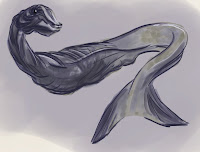 The Andean Wolf, or Hagenbeck's Wolf is an unsubstantited wolf-like canid, reportedly from the Andes.
The Andean Wolf, or Hagenbeck's Wolf is an unsubstantited wolf-like canid, reportedly from the Andes.
.jpg)
.jpg)
In 1927
Lorenz Hagenbeck bought one of three
pelts from a dealer in
Buenos Aires who claimed that they had come from a wild dog of the Andes. When
Dr. Ingo Krumbiegel studied the skin in
Germany in 1940, he concluded that it belonged to a new and still undescribed species. Scientists in the 1960s discovered that the pelt belonged to a domestic dog, possibly a
Sheep dog. A 2000 attempt at
DNA analysis of the remaining pelt at Munich’s zoological museum failed because it was contaminated with human, dog, wolf, and pig DNA, and had been chemically treated (Eberhart, 2002).
.jpg)
.jpg) In 1927 Lorenz Hagenbeck bought one of three pelts from a dealer in Buenos Aires who claimed that they had come from a wild dog of the Andes. When Dr. Ingo Krumbiegel studied the skin in Germany in 1940, he concluded that it belonged to a new and still undescribed species. Scientists in the 1960s discovered that the pelt belonged to a domestic dog, possibly a Sheep dog. A 2000 attempt at DNA analysis of the remaining pelt at Munich’s zoological museum failed because it was contaminated with human, dog, wolf, and pig DNA, and had been chemically treated (Eberhart, 2002).
In 1927 Lorenz Hagenbeck bought one of three pelts from a dealer in Buenos Aires who claimed that they had come from a wild dog of the Andes. When Dr. Ingo Krumbiegel studied the skin in Germany in 1940, he concluded that it belonged to a new and still undescribed species. Scientists in the 1960s discovered that the pelt belonged to a domestic dog, possibly a Sheep dog. A 2000 attempt at DNA analysis of the remaining pelt at Munich’s zoological museum failed because it was contaminated with human, dog, wolf, and pig DNA, and had been chemically treated (Eberhart, 2002).

Comments
Post a Comment